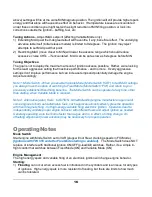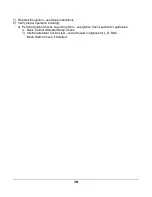
17
2)
Wasted spark
ignitions (E-MAG and others) fire spark plugs in pairs. On any given cycle only
one cylinder, within a Bank pair, is in the compressed
“firing” position. At that same moment,
the companion cylinder is between the intake and exhaust strokes with both valves open. A
wasted spark ignition will fire plugs in both cylinders within the Bank. If sufficient fuel vapor is
present in the companion cylinder due to excess priming, throttle, mixture, or any other reason,
the companion chamber
can ignite. This is called a “wasted side firing” and can send a
pressure pulse down the intake and exhaust pipes
. It’s easily mistaken as a backfire or a kick-
back, which is different. Wasted side firing is remedied by adjusting your starting procedure to
reduce excess fuel.
To reduce the risk of both flooding and wasted side firing,
we recommend you begin your search
for optimal start-up settings on the extreme lean side
and
gradually
modify (increase throttle or
mixture) as necessary to achieve quick and consistent starts.
Lean-limit and mixture control:
The familiar lean-rough boundary experienced with magnetos
will shift (far leaner) or it may disappear entirely. This significantly alters the lean-rough boundary
and the seat-of-your-pants mixture control (lean to rough - then richen).
Ignition Checks:
Your ignition checklist will be extended to test additional features, 1) internal
alternator and 2) Mode Switch (if installed). Both can be blended into your routine left/right Ramp
Check, but the alternator has an additional test (Cut-Out test) that is done on a less frequent
schedule.
1) Ramp Checks (roughly 1700 RPM):
a) Internal Alternator - E-MAG internal alternator operates in parallel with power supplied by the
aircraft bus. The ignition automatically transitions between aircraft power and internal
alternator power as needed. Aircraft power is required for starting and sometimes for low
idle speeds.
i) Running on one side only, turn ignition power test switch OFF for 2-3 seconds and back
ON. The engine should run smooth during this momentary bus power outage which
verifies the internal alternator is working.
ii) Repeat with the other ignition.
Any rough or degraded behavior
(before, during, or after each side’s Ramp Check) indicates
a problem - not suitable for flight.
b) Mode Switch
(recommended on all boosted engines)
– Mode Switch
will be set to
VAR
for
most operations but is
required
for starting.
i) Running on one ignition only, turn Mode Switch from VAR to FIX for 2-3 seconds and
then back to VAR. The engine should run smooth in both positions. The firing position
may change with Mode Switch transitions, so a slight shift in rpm might be expected.
ii) Repeat with the other ignition.
Rough or significantly degraded behavior indicates a problem - not suitable for flight.
c) The power and mode tests can be added to your Left and Right ignition check routine. A
little rehearsal and repetition will go a long way to making the new routine automatic.
2) The Cut-Out test should be done after initial installation, power plant maintenance, and at
annual inspection:



























